Decades before the big-screen Aladdin and Tangled, there were six different Disneyland LP adaptations of these stories, some with ties to Willy Wonka, Doctor Who and The Incredibles.

From the WALT DISNEY Studio
ALADDIN AND HIS WONDERFUL LAMP
Disneyland Records Storyteller Series ST-3989 (12” 33 1/3 RPM LP / Mono)
Released in 1970. Executive Producer/Writer: Jimmy Johnson. Producer/Music Supervisor: Camarata. Conductor: Kurt Graunke. Music Recorded in Berlin by the Symphonie-Orchester Graunke. Dialogue Recorded at Abbey Road Studios, London. Running Time: 26 minutes.
Voices: Tony Brandon (Aladdin); Aubrey Woods (The Magician); Stella Kimball (Aladdin’s Mother); Peter Hawkins (The Sultan); John Benson (The Grand Vizier); John Witty (Genie); David Gell (Narrator).
Music: Selections from “Scheherazade” by Nikolai Rimsky-Korsakov.
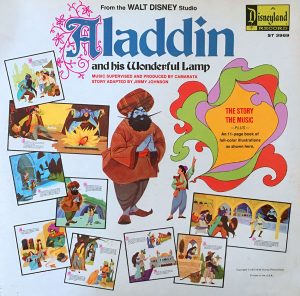 Changes in the children’s record market and at the Walt Disney Studios in the late 1960s and early 1970s necessitated fewer new releases from Disneyland Records, additional reissues and more European productions. Some of the European work began in the late ’50s, when the Symphonie-Orchester Graunke (possibly contracted by Disneyland Records artists and repertoire director Tutti Camarata, as he was long associated with Europe’s finest musicians and orchestras after years working in the U.K. with one of the founders of London Records).
Changes in the children’s record market and at the Walt Disney Studios in the late 1960s and early 1970s necessitated fewer new releases from Disneyland Records, additional reissues and more European productions. Some of the European work began in the late ’50s, when the Symphonie-Orchester Graunke (possibly contracted by Disneyland Records artists and repertoire director Tutti Camarata, as he was long associated with Europe’s finest musicians and orchestras after years working in the U.K. with one of the founders of London Records).
The entire score of Sleeping Beauty was recorded by Kurt Graunke and his orchestra in Berlin with George Bruns and Camarata in attendance, as was the music for the wide screen short, Grand Canyon. It might be surmised that like The Waltz King and other related films of the era were also recorded in Berlin. Camarata and Graunke also recorded a large number of Disneyland classical albums for children and several Buena Vista custom LP’s aimed at audiophiles called the “FantaSound” series. This little-known Disney partnership lasted at least a dozen years.
One of the Disneyland albums intended to introduce kids to great music was Highlights from Scheherazade, a music-only LP with a book with text that describing the Tales from the Arabian Nights. To make further use of this music, Disneyland Records president and avid writer Jimmy Johnson scripted two other Storyteller albums with the same Scheherazade music as background: The Arabian Nights: The Voyages of Sinbad and Aladdin and His Wonderful Lamp.
Both albums featured British voice actors, making them truly international productions, as the final edits, mixes and mastering was done at Camarata’s Sunset Sound studio in Hollywood.
 Of course, the 1970 Aladdin album is nothing like the 1992 Disney animated film. It is an adaptation of the original story, complete with Aladdin’s mother (who was originally going to be part of the 1992 film) and the wicked Magician who pretends to be Aladdin’s uncle.
Of course, the 1970 Aladdin album is nothing like the 1992 Disney animated film. It is an adaptation of the original story, complete with Aladdin’s mother (who was originally going to be part of the 1992 film) and the wicked Magician who pretends to be Aladdin’s uncle.
The Magician is played by Aubrey Woods, who appeared in the 1971 classic Willy Wonka and the Chocolate Factory as Bill, the owner of the candy store who sings “The Candy Man.” (Tim Hollis and your author contacted Woods when we were writing Mouse Tracks: The Story of Walt Disney Records and he responded with fond memories of recording the album.)
Playing The Sultan is a giant among U.K. voice actors, Peter Hawkins. He is legendary as the original voice of the Daleks in the Doctor Who series (as well as the Cybermen). Hawkins’ other voice work includes SuperTed, The Adventures of Noddy and The Adventures of Tintin. Popular British comedian and radio personality Tony Brandon performs Aladdin’s voice for the LP. Brandon did a number of British Disney albums, including Misty, The Mischievous Mermaid, which we talked about in this Spin.
“Bill The Candy Store Owner Traps Aladdin in the Cave”
Just as a quick sample, here’s a “Give me the lamp! scene similar to the one in the 1992 Aladdin, except that Jafar is an unnamed wicked Magician—played by Aubrey Woods, who sang “The Candy Man” in Willy Wonka and the Chocolate Factory.
The Story of ALADDIN AND HIS LAMP
Disneyland Book and Record LLP-356 (7” 33 1/3 RPM LP / Mono)
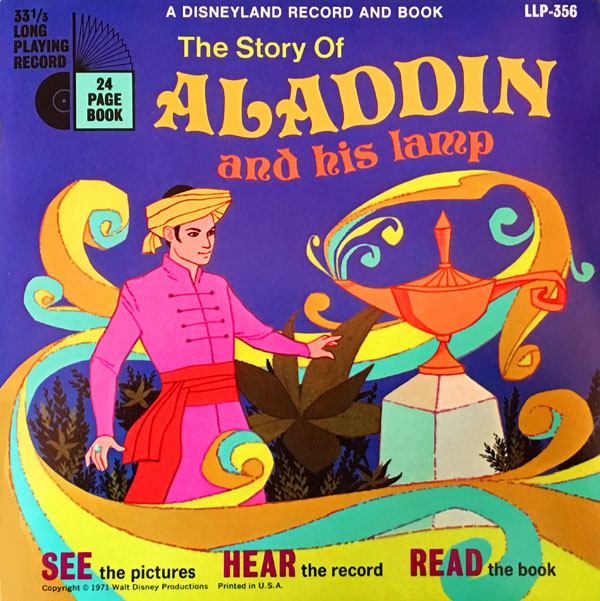
Released in 1971. Executive Producer/Writer: Jimmy Johnson. Producer/Music Supervisor: Camarata. Conductor: Kurt Graunke. Music Recorded in Berlin by the Symphonie-Orchester Graunke. Narration Recorded at Abbey Road Studios, London. Running Time: 11 minutes.
Disneyland Story Reader: Lois Lane (Lois Wilkinson)
Music: Third Movement from “Scheherazade” by Nikolai Rimsky-Korsakov.
When Lois Wilkerson decided to change her name, she looked no further than the Superman comic books. The 26-year-old television and radio singer became the Disneyland Story Reader for Disney’s U.K. book and record sets following Robie Lester’s record-breaking run (Robie remains the performer who appeared on more individual Disney recordings than any other in history).
Lois Lane was the only other Disneyland Story Reader until Producer Jymn Magon reformatted the series with full casts and various narrators in 1977, starting with The Rescuers. Lane appeared on only one 12-inch Disneyland LP, at least in the U.S., as the narrator and soloist on a Disneyland Storyteller album combining the stories from the Columbia Pictures films Born Free and Living Free.
The Aladdin read-along is done in the same format as its predecessors, with Lane reading the text without background music or sound effects, followed by a separate musical portion. In this case, the music is an entire movement from the Scheherazade LP. This read-along is notable for its illustrations (uncredited), which have a Rankin/Bass or UPA look to them. Disneyland Records often chose artwork that went beyond the expected norm—an visual variety that, like the eclectic audio, was a quality of the label the still warrants wider appreciation.
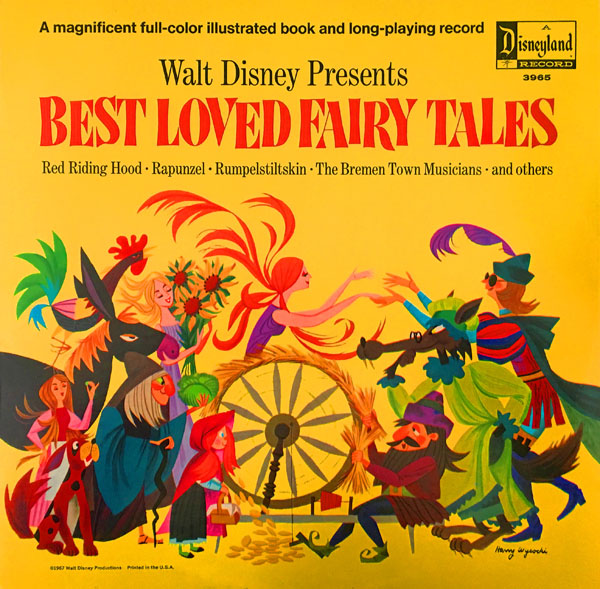
Walt Disney Presents
BEST LOVED FAIRY TALES
The Stories Children Love to Hear Over and Over Again
Told by Rica Moore
Disneyland Records Storyteller Series ST-1918 (12” 33 1/3 RPM LP / Mono)
LP Reissues: DQ-1284 (as Little Red Riding Hood, 1965); ST-3965 (as Best Loved Fairy Tales, 1967 with Book)
Originally Released in July, 1962. Executive Producer/Writer: Jimmy Johnson. Producer/Music Supervisor: Camarata. Conductor: Kurt Graunke. Recorded at Sunset Sound, Hollywood. Musicians: Red Mitchell (Bass); Larry Bunker (Bongos and Vibraphones). Running Time: 27 minutes.
On the subject of going beyond the expected norm, this album is far more daring and progressive than it looks from its unassuming package (and its repackaging).Stories: “Little Red Riding Hood,” “Clytie,” “Rapunzel,” “Rumpelstiltskin,” “The Princess and the Pea,” “The Bremen Town Musicians.”
Instead of lilting narration set to adorable, tinkly music (which is nice too, when done well), Best Loved Fairy Tales is narrated by Rica Moore in a friendly but very direct way, almost adult. There is a sense of passing along valuable information she has just learned that is vital for you to know immediately, but you must keep it strictly confidential. It is 99% sugar-free.
Even more unorthodox is the free form jazz musical presentation. Like beatnik poetry in a Greenwich Village coffee house, the stories are accompanied by bongos, bass and some cool vibes. And I mean the coolest, man. Like straight from once upon a time, cats.
Musicians don’t always get album cover credit, especially on children’s records, but veteran Hollywood “sidemen” Red Mitchell and Larry Bunker share the well-deserved honors with Rica Moore. Both played on hundreds of soundtracks and recordings. Bass player Mitchell played with Tony Bennett, Billie Holiday, Stan Kenton, André Previn, and many more. Bunker, who plays vibraphone and bongos, has played on movie soundtracks for over 50 years, including Disney•Pixar’s The Incredibles and such names as Peggy Lee, Diana Krall, Ella Fitzgerald and Quincy Jones.
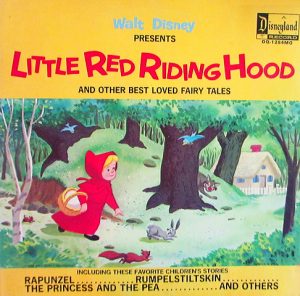 The illustrations are by folk artist Harry Wysocki, who along with his brother Charles, is known for his designs adorning craft projects, jigsaw puzzles and other related items. Wysocki created art for several Disneyland Storyteller books, including The Sound of Music (which is the only story recording based on Ernest Lehman’s Fox film screenplay), narrated and sung by Broadway’s original Maria Von Trapp, Mary Martin.
The illustrations are by folk artist Harry Wysocki, who along with his brother Charles, is known for his designs adorning craft projects, jigsaw puzzles and other related items. Wysocki created art for several Disneyland Storyteller books, including The Sound of Music (which is the only story recording based on Ernest Lehman’s Fox film screenplay), narrated and sung by Broadway’s original Maria Von Trapp, Mary Martin.
The original Brothers Grimm version of Rapunzel is told with no frills, complete with the blinding of the Prince (this album doesn’t shy away from some of the dicey fairy tale moments). Like so many fairy tales, adapting Rapunzel to feature length presented a challenge of adding substance without padding. Hearing the bare-bones tale told on the record is a reminder of how Tangled is one of those features that only gets better over the years. Considering how the creative team transformed the basic tale into such a witty, tuneful blend of appealing characters and serpentine mind games, it’s possibly the most ingratiating princess feature of recent years.
The Best Loved Fairy Tales album was first released within a series of Storyteller LP’s without books, then it was reissued as Little Red Riding Hood and Other Best Loved Fairy Tales. Finally, it was given full Storyteller book and record treatment along with its original title in its third release. The crazy jazz idea worked!
This album was so successful, another set of stories was released in the same style, headlined by Goldilocks and The Three Bears, also narrated by Moore with four jazz players instead of two.
“Best Loved Fairy Tales”
Because the jazz music and Moore’s cool approach were so striking, radio stations actually played selections from this album. According to Tutti Camarata, after Walt Disney heard “Little Red Riding Hood” in his car, he was so impressed that he told his in-house record company staff, “We should have done something like that.” Uncle Walt was pleasantly surprised to learn that it was a Disneyland Record. (Rapunzel can be found at 07:55)
The Story of RAPUNZEL
Disneyland Book and Record LLP-356 (7” 33 1/3 RPM LP / Mono)
Released in 1970. Executive Producer/Writer: Jimmy Johnson. Producer/Music Supervisor: Camarata. Conductor: Kurt Graunke. Music Recorded in Berlin by the Symphonie-Orchester Graunke. Narration Recorded at Abbey Road Studios, London. Running Time: 10 minutes.
Disneyland Story Reader: Lois Lane (Lois Wilkinson)
Song: “Lonely For My Love (Rapunzel’s Song)” by Tutti Camarata, Sung by Katie Briggs.
This recording does not relate to Best Loved Fairy Tales so much as to 1971’s Silly Symphonies, a very strange LP that doesn’t have anything to do with the actual Silly Symphony cartoons but instead contains eight songs that were also used with Disneyland book and record sets. The album was explained in detail in this Spin.
“Lonely for My Love (Rapunzel’s Song)”
Camarata wrote several songs for the album, including this tune for Rapunzel, a lovely ballad reminiscent of Snow White’s “I’m Wishing.”


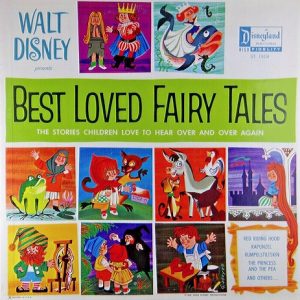
 GREG EHRBAR is a freelance writer/producer for television, advertising, books, theme parks and stage. Greg has worked on content for such studios as Disney, Warner and Universal, with some of Hollywood’s biggest stars. His numerous books include Mouse Tracks: The Story of Walt Disney Records (with Tim Hollis). Visit
GREG EHRBAR is a freelance writer/producer for television, advertising, books, theme parks and stage. Greg has worked on content for such studios as Disney, Warner and Universal, with some of Hollywood’s biggest stars. His numerous books include Mouse Tracks: The Story of Walt Disney Records (with Tim Hollis). Visit 





















































I’ll drink to that, especially since “Princess and the Frog” was a convoluted mess and “Frozen” had a ton of story issues as well. “Tangled”, while not up there with my favorite Disney films, is definitely the best of the three modern-day princess features.
I disagree there. I thought both aforementioned films were better than “Tangled”. While “Tangled” was okay, it didn’t really cling with me like the others did (perhaps partly because I didn’t see “Tangled” in theaters and waited till it was on DVD). The main parts I did enjoyed were the pub scene, the first scene with Mother Gothal and Rapunzel, and the lanterns song sequence. I also seemed to recall Jerry was a bit disappointed with the film in his review on “Cartoon Brew”.
So what was it about “Frozen” and “Princess and the Frog” that made you like both of them better than “Tangled”, Nic? Aside from the fact that you apparently caught those on the big screen and Tangled only on DVD.
I just find some of the characters a bit more relatable. I don’t have a definite answer to be honest.
I certainly found both Rapunzel and Eugene very relatable, definitely more so than the leads of The Princess and the Frog (most of all due to story issues). Some of the characters in Frozen I liked better than Princess, but it didn’t have as coherent a story as Tangled did.
I always thought it was Richard Haydn as the Magician on the “Aladdin” album. I’m surprised to learn here that it’s another actor entirely. There is certainly a vocal resemblance.
The voice acting overall, though good, lacks the urgency needed in good storytelling. The story itself seems a little watered down from the original…and there is very little suspense. Aside from those quibbles, it’s a competent, professional recording and certainly a good supplement for classroom teaching of the story of “Aladdin.” Definitely a far cry from the later feature film version. The “Scheherazade” music dresses it up, for sure.
I would actually vote for “Tangled” over “Frozen,” although I like both. I enjoyed at long last seeing Disney’s take on the “Rapunzel” story and I felt it had the right emotional power. I found the character of Rapunzel more appealing than either Elsa or Anna–but what do I know? I’m a guy! My preference is still for hand-drawn animation, but the computer-generated animation in these latter-day Disneys is interesting to look at.
I agree that the Rica Moore recording “worked” with “the crazy jazz.” It was a delight to hear those stories. Thanks for posting them. Ms. Moore seems to have been busy around Disneyland Records during that era. She also did two mathematics albums with Jiminy Cricket–which I believe have been discussed here in previous posts a few years back.